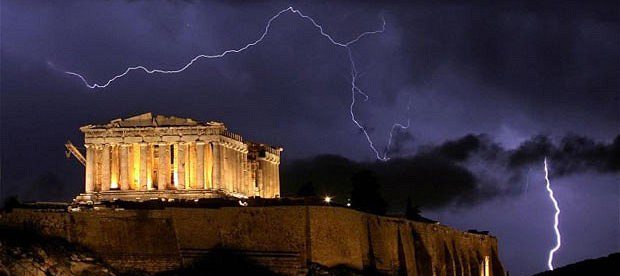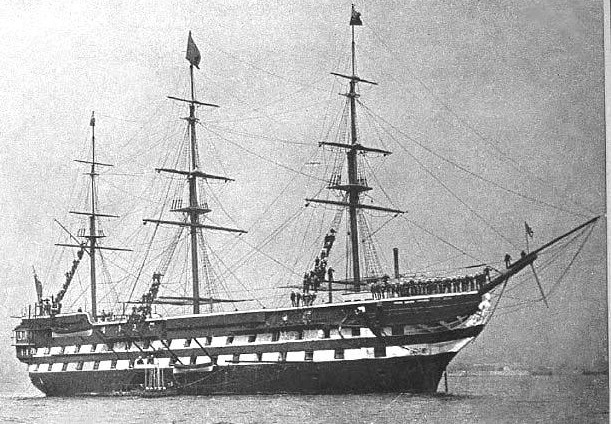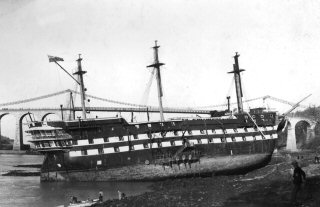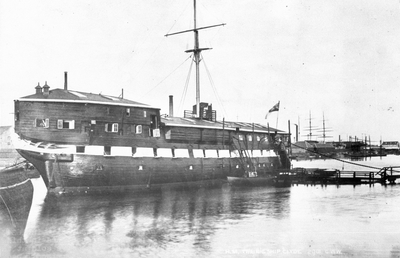The Royal Naval Reserve
Henry W A Littledale, Commander HMS “Clyde” RNR (h.4-Queens Gardens c.1893)
Naval Establishment c.1882
HMS “Clyde,” 5th Rate Frigate, 38-Guns, 1,447-Tons. Drill Ship for the Royal Naval Reserve, Moored in Victoria Dock.

Permanently Berthed in Aberdeen Harbour was HMS ‘Clyde’ a Naval Training Ship. and former Man o’ War with 38-Guns & 1081-Tons displacement. It served as an RNR Training Ship. The Ship was open to Visitors on Sunday Mornings. After being ‘Paid -Off’ from Victoria Dock the Hulk was towed away to Clydeside to be scrapped.
The above Image shows the Captain’s Cabin looking onto the Stern Buoy Mooring with the Gun Ports clearly defined below the enclosed Training deck. Given the imprecise construction methods employed on Leda-Class Ships, not to mention the RN‘s Rostering System, their exact dimensions & compliments, while similar, fluctuated to a degree. On average, each Ship was as follows:
Modified Leda Class 46-gun 1820-30
Type – 5th Rate Frigate
Length – Lower Deck 150-ft; Keel 125-t
Breadth – 40-t
Weight – 1053-Tons
Crew – 284
The Main Gun Deck, with its 28 x 18-Pounder Cannons would have been supplemented on the Forecastle Deck with 2 x 9 Pounders and 2 x 32-Pounder Carronade Guns with 8 x 9-Pounders on the Quarter Deck along with 6 x 32-pounder Carronades.
Total 46-Guns
HMS Clyde was a 46-Gun 5th Rate Frigate Launched in 1828. She became a Drill Ship for the Royal Naval Reserve in 1870, and was Sold in 1904.
1871, 18th October: The Aberdeen Press & Journal reported as follows:
New Guns for the Clyde Training Ship. – One of the Government steam lighters arrived here some time ago with 3-Guns to be placed on board the Training Ship ‘Clyde’ (1,081-Tons) here. The Vessel was hauled down on Thursday to the Sheer Poles, and has since received the Guns on Board. One is a new 7-Ton Rifled Gun, capable of throwing a 100-lb. projectile with a charge of 36-lbs. The others are 32-Pounders. A Patent Gun Carriage on a new principle for the 100-Pounder has also been provided.”
‘HMS Winchester was a 60-gun Southampton-class Sailing Frigate of the Royal Navy. She was laid down in 1816 at Woolwich Dockyard, and Launched on 21st June 1822. Although designed for 60-guns, she and the rest of the Class carried 52 guns. From 1831 to 1861 she Served in North America & South East Asia. In 1861 she became the Training Ship Conway at Liverpool; and she was used as an Educational Vessel for homeless & destitute children. From 1876 she was the Training Ship Mount Edgcumbe. She was Sold in 1921.
The whole South Side of the Upper Dock in Aberdeen Harbour was once occupied by Shipbuilding Yards. At the South-east corner of this Dock was also moored HMS Winchester, for the Training of the Royal Naval Reserve. She was approached by a floating Gangway that ran Westward from Regent Bridge. When a Ship’s Launch took place from the Inches Shipyards in the Upper Dock Harbour the Winchester had sometimes to be moved to make way for it.
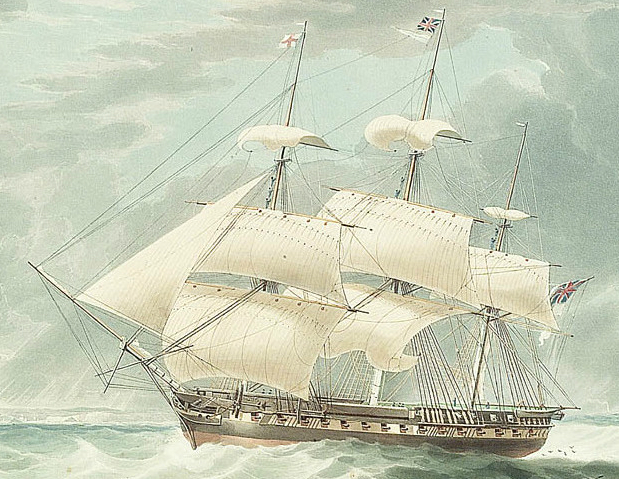
HMS Winchester
A 38-Gun RNR Training Ship was a familiar sight in the Harbour for many years. HMS Winchester was a Man o’ War of 1081-Tons. The Ship was for a long time Moored in the Upper Dock connected to the Quayside by a Floating Gangway, the Ship was open to Visitors on Sunday Mornings. A Display of Cannons & Cutlasses was also a Tourist Attraction. Commander, Ian R Horn, Fleet Surgeon William Edward Rennet, & Fleet Paymaster, Samuel Lark. 1st July 1862, Commanded by Commander Charles John Balfour, Aberdeen, Royal Naval Reserve Drill Ship.
HMS Conway was a Conway-Class 6th Rate of the Royal Navy, built by Chatham Dockyard and Launched on 2nd February 1832. She was lent to the Mercantile Marine Association of Liverpool in February 1859 to act as a Training Ship for Cadets and gave her name to HMS Conway, a Series of Ships & Shore-based Schools. When HMS Winchester took her place as the Training Ship in 1861, the 2-Ships swapped Names. Under her new name of Winchester, she became the 1st Aberdeen Royal Naval Reserve Ship on 28th August 1861 and was Moored in the Upper Dock. She was broken up at Sheerness (Medway) in 1871, a process that was completed on 3rd June 1871.
1859 – The Royal Naval School was 1st Established on a small Frigate, the Conway, moored in the Mersey at Rock Ferry, Birkenhead 1861. Replaced by larger Frigate Winchester which was renamed Conway, while the original Conway was renamed HMS Winchester & used as an RNR Drill Ship at Aberdeen.
1875 the 2nd Conway was too small and was replaced by the Nile Built in 1839 as a 92–Gun Ship of the Line. She was renamed Conway, while the 2nd Conway, which had been Winchester, was renamed Mount Edgecombe and went to the Devonport & Cornwall Industrial Training Ship Committee at Plymouth.
From Mersea to Menai; In 1941, with Air Raids on the Liverpool docks taking place, Conway had already survived several near misses. It was decided to move the Ship from the Mersey to Anglesey, where she remained moored for the duration of the War between the former Bishop’s Palace at Glyn Garth and the Gazelle Hotel, in line with the Catalina Flying Boat moorings along the Anglesey shore. This being wartime there was no official announcement of the move and local residents were startled one evening to see a picturesque Nelson-era Ship of the Line, a “Wooden Wall”, entering the Menai Strait. Subsequently, Ship-to-shore traffic was across the Menai Strait to the Pier-head at Bangor or to the Gazelle Hotel Ferry Terminal and she became something of a local Tourist attraction. At the end of the 1940s there was a surge in demand for Merchant Navy Cadets. The Sip did not have space for more Cadets so the Ship’s Superintendent, Captain Goddard, started looking for space Ashore with Playing Fields and a Shore Establishment. He picked on Plas Newydd, the stately home of the Marquess of Anglesey, a large part of which had been vacated by the US Army Intelligence Corps at the end of the War. This Site seemed ideal, except that the Seabed provided very poor Anchorage, so 4 No. 5-Ton Anchors were sunk there. Only one problem remained: could the Ship be moved there in one piece? She would need to be Twed by Tugs through a stretch of water between Anglesey and the Mainland, known as the “Swellies“. This area, bounded by the 2-Menai Bridges (the Menai Suspension Bridge & Britannia Bridge), is notorious for underwater shoals & dangerous, complex tidal streams as well as a non-tidal current varied by the wind & atmospheric pressure. Captain Goddard was proud of his experience as a Hydrographic Surveyor, and having studied the problem, believed it was possible. After a false start the day before, the Ship was moved successfully on 13th April 1949, in spite of what was obviously a great risk. Conway remains by far the deepest Ship ever to have passed through the Swellies. Her Draught was 22-ft (6.71M) aft and the underwater clearances were marginal. The overhead clearance under Menai Suspension Bridge, which is 100 feet (30.48 m) above high water, was estimated to be 3-ft, all depending upon the actual height of the Tide at the time of passing through. “I was glad when it was accomplished,” Captain Goddard wrote. “It created a great deal of interest amongst the North Wales seafaring fraternity who had declared the undertaking to be a foolish one.
Loss of the Ship: By 1953 another refit was due. This could not be done locally so the Ship had to be taken back to Birkenhead Dry Dock, passing back through the Swellies once more. The operation took place on 14th April 1953. There were the same 2- Liverpool Tugs which had shifted her several times before, Dongarth Forward & Minegarth Aft. The new Captain Superintendent, Captain E Hewitt, was in Command, with 2-Trinity House local Pilots – Mr R D Jones (Jr) aboard the head Tug & Mr R J Jones (Sr) – advising Captain Hewitt, and the Blue Funnel Liverpool Pilot Mr James Miller overseeing the Towage. High water at Liverpool that morning was 11:18, at a height of 32’10” and was the highest Tide that year. Laver’s Almanac quotes high water at Menai Bridge as 28-mins before high water Liverpool. What is termed ‘slack’ in the Swellies is actually a brief period of uneasy equilibrium between 2 opposing Flood streams which typically occurs 1-hr 42-mins before local high water, or at 09:08 on the morning of the move. Owing to the strength of the Southwest-going Ebb, which runs at 8-Knots during a Spring Tide, there is a confused complex Tidal Flow among the numerous rocks & islets generating many powerful Eddy’s. On a big Tide in particular it is vital for an Outbound Vessel to be through the Swellies before the Tide turns against her. It is therefore the local practice to start an Outward Transit with the last of the Northeast-going Flood 20-mins before the ‘Slack’, or at 08:48 on the morning of the move. Captain Hewitt had worked with the Caernarfon Harbour Master, Captain Rees Thomas, in preparing his plan, and had several times made a Passage of the Swellies in the Conway‘s Motor Boat, checking his timings at 4 knots (7.4 km/h; 4.6 mph). He also consulted Conway‘s old Log Book for the timings of the previous Transit, and had planned to arrive at the Bridge at 09:20.
The Streams in the Menai Strait are affected by Winds outside in the Irish Sea. With a strong North or North-westerly wind both the rate and duration of the Southwest-going Ebb are increased, and the Southwest-going Ebb may begin quarter of an hour earlier. The 0600 Synoptic Chart showed a stationary deep depression West of Norway with a Secondary Low in the North Sea, and a High steadily closing the West Coast of Ireland, which could be expected to result in an increasingly strong Northwesterly wind in the Irish Sea. But in the shelter of the Plas Newydd Mooring, there was no indication of this. At 0800 as the Wind was being recorded in Conway’s logbook as northerly force 1–2 (2 to 5 knots), only 13 miles away on Station off Point Lynas it was being recorded by the Liverpool Pilot Boat as Northwesterly Force 6 (22/27-Knots) and her Noon entry was NW Force 7, (28/33-Knots) while during the morning Bidston Observatory was recording Gusts up to 49 Knots (Storm Force 10). The Investigating Subcommittee was later to express its surprise that Captain Hewitt had left the Plas Newydd Mooring without a Weather Forecast, and “had no knowledge of the stormy conditions prevailing at sea at the time Conway was to make the Passage” since it was Local knowledge that in such Weather “abnormal conditions might be encountered.” In addition to the Tide generated streams in the Menai Strait there is also a non-Tidal Current, the Southwest Residual, a dynamic reaction which directly reflects wind stress in the Irish Sea. The North-westerly mean wind speed of 16Ms per sec at Sea that day would enhance the Residual by 15cm per sec, increasing the strength of the Southwest-going ebb at Plas Newydd by as much as 3-Knots.
Conway’s Logbook shows she left the Mooring at 08.22 and arrived at Britannia Bridge at 0850, which was the locally recommended time for starting the Outward Transit and Jones the Pilot naturally advised keeping her going with the last of the northeast-going Flood Tide behind her. Instead Captain Hewitt had the Ship brought up for half an hour to wait until 09.20. The severe wind in the Irish Sea caused the Stream in the Strait to turn to the Westward earlier which eliminated the brief slack water period. Captain F J Durrant, Marine Manager of the Towing Company, observed “The anticipated 10-min slack water did not materialise. The Ebb set in immediately the Flood ended at 09.20.” With the Ship far too late and sensitive to the adverse conditions the Pilot advised going back. Captain Hewitt passed the ship under Britannia Bridge at 09.23 even though the Ebb Tide was already setting against him. Only 17-mins later, “At 09.40 – the forward tug Dongarth was towing at full Speed against the Tide but making no further progress.” By 10.10, 47-mins after passing under the Bridge, the Tow was still in much the same position having made good only 0.6 of a mile from the Bridge, giving the Tide another half an hour to develop further, yet it was not until then that Captain Hewitt had the Stern Tug slipped and sent forward to assist the Head Tug, when “Headway became slight but noticeable.” By 10.20, already a full hour into the Ebb, the Pilots had worked the Ship across the Tide and into the Eddy which the Admiralty Sailing Directions states forms near the Anglesey shore close Westward of the Northern Ppier of the Suspension Bridge, and intended Holding her there in the safety of this until the strength of the Tide had abated. Instead, with only 750-ft (230M to go to the Bridge, Captain Hewitt ordered that the Ship be put back in the Channel and this was done. Almost immediately, at 10.30, she was caught by an Eddy of overwhelming strength which drove the Ship ashore over The Platters. “This disastrous sheer occurred and was concluded in a matter of seconds.” Contrasting with the 18-mins she had taken to complete the Inbound Transit, the Outbound Ship had been 1-hr 7-mins covering the 1200-yds from Britannia Bridge where the Pilot had advised going back. After both tugs on full speed for 10-mines had failed to make any impression they were instructed to stand by at Menai Bridge Pier for another attempt to re-float her on the evening Tide when there would be a better opportunity if the Weather at Sea Moderated.] A 3rd Tug, Grassgarth, sent out at 14.30 to assist in Towing her off was forced to put back to Liverpool through stress of Weather.
The Wreck of Conway; – While her forepart planted firmly on the Shelving Shore her Stern was floating in 30-ft of water. As the Tide fell the stern lost its support causing the ship to become severely Hogged. Her Seams opened, and about her Midship Sections the height between Decks was reduced from over 6-ft (1.8M) to less than 4-ft (1.2M). “Conditions on board were very bad with the after end of the Ship from the Mainmast sagging downwards, and the continuous sound of cracking, twisting, rending Timber & Rushing Water below.” When the next Tide made the Stern fail to lift and the Ship flooded freely through her open Seams. Being evident that further attempts to Tow the Ship off would be to no purpose, the Tugs were discharged and left for Liverpool the following morning. Two days after the Grounding, in the evening of 16th April 1953, Surveyors declared Conway a total Constructive Loss. The Ship was not Insured.
HMS Conway was under Tow from her normal Mooring at Plas Newydd to Birkenhead up the Menai Strait. The Swellies between the Welsh Mainland & Anglesey. The differential Tides at the 2 ends of the Strait cause very strong currents to flow in both directions through the Strait at different times, creating dangerous conditions. One of the most dangerous areas of the strait is known as the Swellies (or Swillies – Welsh Pwll Ceris) between the 2-Bridges. Here, rocks near the surface cause over-falls and local whirlpools, which can be of considerable danger in themselves and cause small boats to founder on the rocks. This was the site of the loss of the RNR Training ship HMS Conway in 1953. Entering the strait at the Caernarfon end is also hazardous because of the frequently shifting sand banks that make up Caernarfon bar. Close to a place called the Platters on the Caernarfon side of the Strait she ran aground due to strong currents and could not be refloated. She caught Fire 30th October 1956 during dismantling & burnt to the Waterline.
A 5th Rate Frigate, the Clyde, was Built about 1820 and served in Aberdeen from September 1870 until June I904.
The 1st HMS Clyde was a 38-Gun Frigate of the ‘Artois/Apollo’ Class, Built at Chatham Dockyard, and Launched in March 1796. She carried a Complement of 270-Officers, Ratings & Marines. Although her career was short (she was broken up in 1805), it was very eventful and she saw action on several occasions. When Mutiny broke out at the Nore in the Thames Estuary in 1797, the Clyde’s Captain was able to persuade his Crew to return to their Duty – one of only 2-Ships to break the Mutineers’ Blockade & Escape into the Medway. The 2nd HMS Clyde is the only example since the 1740s of a ‘Rebuild’, a new Ship Built to the same Design (& name) as one recently scrapped, whilst the 3rd was a ‘Leda’ Class 38-Gun Frigate, the largest Class of Sailing Frigates ever built, and was Launched at Woolwich Dockyard in October 1828.



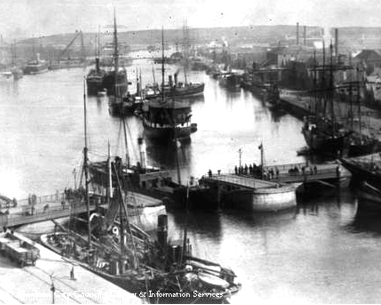
HMS Clyde in Aberdeen Harbour. She was a Training Vessel for the Royal Naval Reserve and was Moored in the Victoria Dock.
This is the old Regent Bridge at the bottom of Marischal Street which swung in 2-halves with a Centre Island similar to the old Lock Bridges at York Place seen in the Distance. In the background is HMS Clyde a Royal Navy Reserve Ship for Training Cadets. The old Regent Swing Bridges were replaced by a single Steel Framed Swing Bridge operated on a single Pivot by Hydraulics from the Regent Road Side of the Harbour.
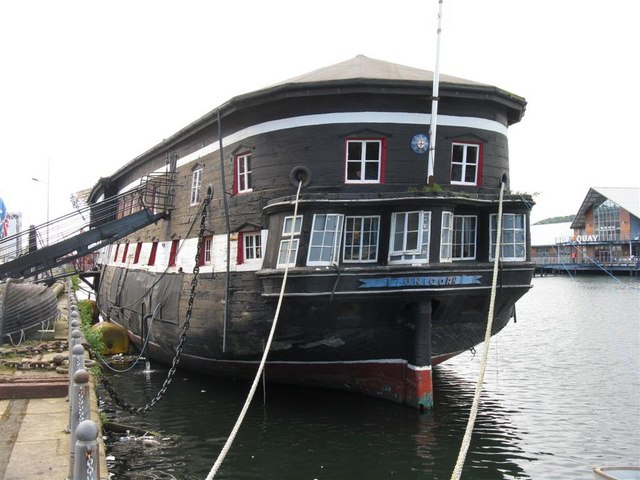
HMS Unicorn (now a Museum Ship in Dundee) was designed as one of the last of the successful Leda Class Frigates, 150ft long in the Hull and principally Armed with a combination of 18-Pounder Long Guns & 32 pounder Carronades. Their Lines were based on a French Frigate, the Hebe, captured in 1782, and the whole Class was one of the best of the age. It included such fine Ships as the famous Shannon, which captured the American Chesapeake, & HMS Tricomalee which was recently extensively reconstructed at Hartlepool, and which is the only Ship afloat in Britain older than Unicorn. The Class was originally rated 38-Guns, but under the new Establishment of 1817 they were all re-Rated as 46-Gun Frigates, to reflect the importance of their Carronade Armament. A carronade is a short, smoothbore, Cast-iron Cannon which was used by the Royal Navy and first produced by the Carron Co, Ironworks in Falkirk; The Company also made Ammunition, including some invented by Henry Shrapnel. It was shorter and much lighter than a Long Gun of the same Calibre, meaning that more could be carried, and it was also quicker to load and required a smaller Crew. On the debit side, Carronades had a short Range.
 The Trincomalee belonged to a large Class of 38-gun Fifth Rates that have a strong claim to being the Royal Navy’s standard Frigate type for the whole of the Napoleonic Wars. Following the success of the Shannon against the Chesapeake in 1813, the Class was chosen as the post-war mass-production design. Intended to replace large numbers of worn-out war-built Frigates, this programme emphasised the quality of construction for longevity and included a number built of teak at Bombay in India. One of these was Trincomalee, launched in 1817. This appraisal reflects the multiple significance of the Ship – its place in the development of the Frigate, the importance of the teak building programme in India, its role in the changing world of the 19th-century Royal Navy, and even its last contribution as a Training Vessel for young Seamen. Because the teak hull was considered resistant to extremes of climate, most of the Ship’s active life was spent on American Stations – the West Indies, Newfoundland, and later the North Pacific & Arctic – combining Imperial Policing Duties with Oceanography & Exploration. The resilience of teak was further proved by a long period of Harbour service, and even after a century of relative neglect the Hull was found worthy of immensely costly restoration. The work carried out on the Ship must be one of the most thorough, historically accurate & painstaking projects of its kind, and is an exemplary lesson to Wooden Ship Preservation movements throughout the World. Individual chapters cover each aspect of this varied career, concluding with a look at the way the Ship is now being used to bring alive the details of Naval life in the age of Sail.
The Trincomalee belonged to a large Class of 38-gun Fifth Rates that have a strong claim to being the Royal Navy’s standard Frigate type for the whole of the Napoleonic Wars. Following the success of the Shannon against the Chesapeake in 1813, the Class was chosen as the post-war mass-production design. Intended to replace large numbers of worn-out war-built Frigates, this programme emphasised the quality of construction for longevity and included a number built of teak at Bombay in India. One of these was Trincomalee, launched in 1817. This appraisal reflects the multiple significance of the Ship – its place in the development of the Frigate, the importance of the teak building programme in India, its role in the changing world of the 19th-century Royal Navy, and even its last contribution as a Training Vessel for young Seamen. Because the teak hull was considered resistant to extremes of climate, most of the Ship’s active life was spent on American Stations – the West Indies, Newfoundland, and later the North Pacific & Arctic – combining Imperial Policing Duties with Oceanography & Exploration. The resilience of teak was further proved by a long period of Harbour service, and even after a century of relative neglect the Hull was found worthy of immensely costly restoration. The work carried out on the Ship must be one of the most thorough, historically accurate & painstaking projects of its kind, and is an exemplary lesson to Wooden Ship Preservation movements throughout the World. Individual chapters cover each aspect of this varied career, concluding with a look at the way the Ship is now being used to bring alive the details of Naval life in the age of Sail.
 The Gun Deck, with its 18-Pounder Cannons, was the key to a Frigate’s fighting ability. Moving into loading & firing positions by muscle alone, each Gun had a Crew of several men to perform these backbreaking tasks. In the Heat of Battle, the Gunners would endure thick smoke & intense heat from their own Cannons, as well as the Threat of Enemy Fire. The Gun Deck was also the location of the Captain’s Great Cabin – a relatively enormous amount of Space given the cramped conditions the rest of the Crew resided in. The Galley Stove is found on this Deck too.
The Gun Deck, with its 18-Pounder Cannons, was the key to a Frigate’s fighting ability. Moving into loading & firing positions by muscle alone, each Gun had a Crew of several men to perform these backbreaking tasks. In the Heat of Battle, the Gunners would endure thick smoke & intense heat from their own Cannons, as well as the Threat of Enemy Fire. The Gun Deck was also the location of the Captain’s Great Cabin – a relatively enormous amount of Space given the cramped conditions the rest of the Crew resided in. The Galley Stove is found on this Deck too.

 To ask the First Lord of the Admiralty, in connection with the Inquiry which has been asked for, and the consideration by the Admiralty Volunteer Committee into the creation of a new Division of the Royal Naval Volunteer Reserve at Aberdeen, if he will consider the Advisability of Holding a Public Inquiry there, with due notice so that a Local Committee might be formed amongst those most likely to be of help in the matter; and if he will keep in view the advantages which would accrue from the retention of HMS “Clyde” as a Drill-hall & Headquarters of the proposed new Division of the Royal Naval Volunteer Reserve. (Answered by Mr McKenna.) As was stated on the 13th instant, the matter referred to by my Honourable Friend is receiving consideration in case an extension of the existing numbers of the Naval Volunteers should be required. The matter has not yet reached a Stage at which a Public Inquiry at Aberdeen would be of Advantage. The old system of Training the Royal Naval Reserve on Board Stationary Drill Ships was being Terminated, and in consequence HMS “Clyde” will be ‘Paid-off’ on or before 31st March, 1911.
To ask the First Lord of the Admiralty, in connection with the Inquiry which has been asked for, and the consideration by the Admiralty Volunteer Committee into the creation of a new Division of the Royal Naval Volunteer Reserve at Aberdeen, if he will consider the Advisability of Holding a Public Inquiry there, with due notice so that a Local Committee might be formed amongst those most likely to be of help in the matter; and if he will keep in view the advantages which would accrue from the retention of HMS “Clyde” as a Drill-hall & Headquarters of the proposed new Division of the Royal Naval Volunteer Reserve. (Answered by Mr McKenna.) As was stated on the 13th instant, the matter referred to by my Honourable Friend is receiving consideration in case an extension of the existing numbers of the Naval Volunteers should be required. The matter has not yet reached a Stage at which a Public Inquiry at Aberdeen would be of Advantage. The old system of Training the Royal Naval Reserve on Board Stationary Drill Ships was being Terminated, and in consequence HMS “Clyde” will be ‘Paid-off’ on or before 31st March, 1911.
Royal Naval training ship ‘HMS Clyde‘ was Towed from its Moorings at Victoria Dock to Clydeside on 17th October 1911.
The Drill Ship enclosed Hulk of the Royal Navy Training Ship ‘HMS Clyde‘ floating high in the water and under Tow by a Steam Tug in the Tidal Harbour. It is just approaching Pontoon No.3 off the adjacent Shipyards, a Bucket Dredger ‘Kantarah‘ stands clear and just in the frame left is the Northeast Corner of Matthews Quay – the Berth for the North Islands Ferries. It’s on is way aptly to the River Clyde for breaking up for Timber Salvage.
Aye – Jist Knocket Oot – instead of being faithfully restored with all the Sea Fairing & Naval Architecture skills already resident in Port.


Foreground Swing Bridge Construction & Sheerlegs In Distance
In 1904 the Composite Screw Sloop HMS Wild Swan became the 4th HMS Clyde in her Role as the Aberdeen Royal Naval Reserve’s 2nd Drill Ship. The above image reflects this statement with a Composite Wood & Iron Ship of finer lines & similar Deck Housings for Drill purposes. Photograph taken from the Regents Bridge Works and before the 2-Storey Storage Shed was built on Regents Quay. HMS Wild Swan was an Osprey Class Sloop Built for the Royal Navy in the mid-1870s. They were of composite construction, with Wooden Hulls over an Iron Frame. Five Ships of the Class were built, which had been Designed in 1874 by the Royal Navy’s Chief Constructor, William Henry White. They were the 1st Ships in the Royal Navy to have Glass Scuttles instead of solid plug Scuttles. She was Launched at Napier’s Yard in Govan in 1877 & became a base Ship in 1904, being renamed Clyde. She was renamed Columbine in 1913 and was Sold for breaking to the Forth Shipbreaking Company in 1920.
Photograph taken from the Regents Bridge Works and before the 2-Storey Storage Shed was built on Regents Quay. HMS Wild Swan was an Osprey Class Sloop built for the Royal Navy in the mid-1870s. She was Launched at Napier’s Yard in Govan in 1877 and became a base Ship in 1904, being renamed Clyde. She was renamed Columbine in 1913 and was Sold for breaking to the Forth Shipbreaking Company in 1920.
The Forth Shipbreaking Company 1904-1920 at Bo’ness, (Borrowstounness) West Lothian.
Shipbreaking at Bridgeness. Mr Turnbull Established a Shipbreaking Yard at Bridgeness in 1898. The 1st Ship Broken was the “Barracouta“, but without Oxy-acetylene (which was introduced in 1903) each Ship was taken apart Plate by Plate. At the end of the WWI a Flotilla of German Submarines were broken at Bridgeness. Other Cargo Ships & P&O Liners such as the “Oriana and the “Orvieto” were also dismantled at Bridgeness. In 1904 the Yard was taken over & renamed The Forth Shipbreaking Company; it was absorbed into the P & W McLellan’s Group in 1921-1970.
HMS Unicorn (now a Museum Ship in Dundee) was designed as one of the last of the successful Leda Class Frigates, 150ft long in the Hull and principally Armed with a combination of 18 Pounder Long Guns & 32 pounder Carronades. Their Lines were based on a French Frigate, the Hebe, captured in 1782, and the whole Class was one of the best of the age. It included such fine Ships as the famous Shannon, which captured the American Chesapeake, & HMS Tricomalee which was recently extensively reconstructed at Hartlepool, and which is the only Ship afloat in Britain older than Unicorn. The Class was originally rated 38-Guns, but under the new Establishment of 1817 they were all re-Rated as 46-Gun Frigates, to reflect the importance of their Carronade Armament. A carronade is a short, smoothbore, C
cast iron cannon which was used by the Royal Navy and first produced by the Carron Co, Ironworks in Falkirk; The company also made ammunition, including some invented by Henry Shrapnel
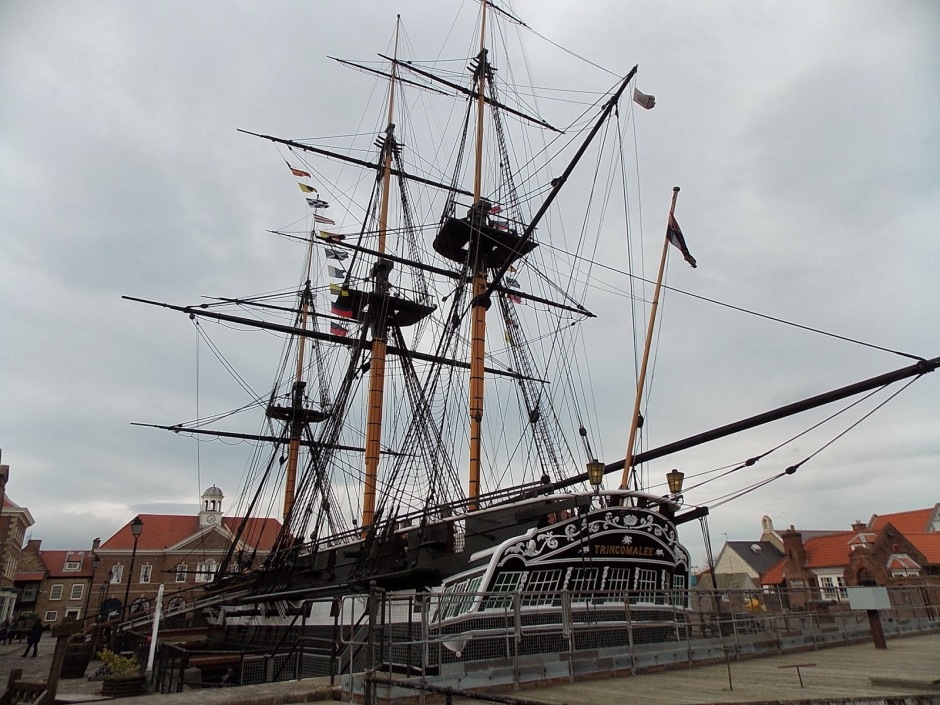
The Trincomalee belonged to a large Class of 38-gun Fifth Rates that have a strong claim to being the Royal Navy’s standard Frigate Type for the whole of the Napoleonic Wars. Following the success of the Shannon against the Chesapeake in 1813, the Class was chosen as the Post-war mass-production Design. Intended to replace large numbers of worn-out War-built Frigates, this programme emphasised the quality of Construction for Longevity and included a number Built of Teak at Bombay in India. One of these was Trincomalee, launched in 1817. This appraisal reflects the multiple significance of the Ship – its place in the development of the Frigate, the importance of the Teak Building programme in India, its role in the changing World of the 19thC Royal Navy, and even its last contribution as a Training Vessel for young Seamen. Because the Teak Hull was considered resistant to extremes of climate, most of the Ship’s active life was spent on American Stations – the West Indies, Newfoundland, and later the North Pacific & Arctic – combining Imperial Policing Duties with Oceanography & Exploration. The Resilience of teak was further proved by a long period of Harbour Service, and even after a Century of relative neglect the Hull was found worthy of immensely costly Restoration. The work carried out on the Ship must be one of the most thorough, historically accurate & painstaking projects of its kind, and is an exemplary lesson to Wooden Ship Preservation movements throughout the World. Individual chapters cover each aspect of this varied career, concluding with a look at the way the Ship is now being used to bring alive the details of Naval Life in the age of Sail.
Presently berthed in Jackson Dock, Maritime Avenue, Hartlepool, TS24 0XZ – Would that Aberdeen City Fathers had the foresight to restore the HMS Clyde at scrap price for similar Posterity while the Local Naval Architectural expertise was available.
Obsolete Men-of-war always contribute a large proportion of the material that comes on to the Scrapping Market. The progress of Warship design is so steady, and the competition so keen, that the older Ships are always going to the Shipbreakers in a steady stream. Even when international agreement periodically postpones the bigger Ships being cleared off the list by giving them longer agreed lives, the smaller Vessels go to the Yards in undiminished numbers. The scrapping of Men-of-war is always worthwhile so that there is the keenest competition to get hold of them. Before the War of l914-18, they were collected in batches in one or other of the Anchorages popularly known as “Rotten Row” and periodically offered for Sale by Public Auction. The bidding was supposed to be strictly controlled, certain Ships being reserved for National Buyers only, whereas others, of smaller importance, could be bought by anybody.
The most famous Ship to be broken up in Rotherhithe was the 98-Gun 1st Rate Ship of the Line HMS Temeraire, which was broken up at the Beatson Surrey Canal Wharf Site in 1838. The Ship was immortalised in J M W Turner’s fabulous Oil painting “The Fighting Temeraire” She had performed an important role at the Battle of Trafalgar under the Command of Captain Sir Eliab Harvey, and was justifiably well known in her own time. The Painting is not an accurate depiction of the Ship, or even the event (she was guided along the Thames by 2-Tugs, Sampson & London, not just the one shown in the painting). Turner had seen Temeraire quite by chance from one of the Steamships that carried Passengers between London & Margate.
The Pioneer of Wooden Shipbreaking and the re-cycling of material & parts was Henry Castle’s of Baltic Wharf, Millbank, on the River Thames in 1838 and later at Charlton & Woolwich. They specialised in Wooden Warships, and for example, Liberty’s of London, the famous Shop, was rebuilt in 1922 using Oak from the Training Ships Impregnable & Hindostan that were broken-up on the Thames. Castle’s also kept the Figureheads, which were later restored by the Admiralty and displayed at Dockyards & Shore Establishments. For many years Castle’s took the greatest care of the Figureheads of the Ships which they broke up. When, after a long period of neglect, the Admiralty suddenly realised that such Trophies were of great value to the morale of the Service, it was enabled to make the Famous Dockyard Collections principally through the co-operation of the Scrappers. A number of Figureheads were still to be seen at Millbank, and others have gone to Museums all over the Country. The Late King George V was particularly interested in relics made from the material of Old Ships. On the breaking-up in 1910 of the Cruiser Melampus, which he had Commanded when he was Duke of York, he had a Garden Chair made from her Teak for his own use and a Suite of Garden Furniture for Queen Alexandra. Even today there is a big sale for articles, large & small, made from Man-o-war Teak; but in modern Ships, this material is virtually confined to the Teak Decks.
This is at least the 2nd case of Scrapyard “Dealers” doing a great Service for British Heritage that I am aware of. The other was Dai Woodham of Barry, South Wales who Held on to over 200-Steam Locomotives instead of scrapping them.
